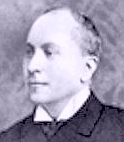The medicine, she said, began to work at once, and brought on pain in the muscles of the back of the neck which spread all over the head, being especially severe on the left side and in the region of the growth; this continued for three or four days and then left. The growth is now (February 6) a fourth its original size, black-looking and shrivelled, and evidently drooping off. Reports, February 25 I am quite well now.”
LONG-LASTING LUPOID WART.
A lupoid wart, almost the same in size, situation, and appearance as the last, and in a patient of the same age, sex and temperament dark haired and bilious came to me in December, 1899. Here the wart has existed all her life, but has increased during the last year. The Ferrum Picr. 3x acted at first in much the same way, causing pain in the cerebellum of the same side, and a chipping off of particles of the wart; then it seemed to cease acting and the patient went to italy, and returned with the disfigurement unchanged in size. When I saw it in May, 1900, I had great difficulty in convincing the patient that it looked less vitalised. This, however, was evidently the case, for on resuming the Ferrum Picr. 3x, and using a lotion of Acid. Picr. 3x Gtt. x 3ij. locally, it dwindled away to a third of its original size.
In a case where a working man had a large wart on his middle finger, that had become firmly attached to the periosteum of the second phalanx, and where all kinds of local applications had been used; I directed Ferrum Picricum 3x to be given, 7 drops diluted, to go over a fortnight, and at the same time cautioned him that in all probability the wart would not go away till two or three weeks after he had finished the medicine. It ultimately went away, not a trace of it was to be seen six weeks after he had taken the medicine.
The sphere of Ferrum Picricum in old standing cancer cases has been with me that of an intermediate remedy, and if given as such in high dilution it is an indispensable help. Among other indications for it are recurring attacks of jaundice, with tendency to disturbed dreams, coated tongue, mushy stools, or constipation: with, in the male, enlarged prostate, and in the female, retroverted womb and pelvic blood stasis.

